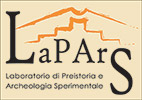Metallurgy
Knowledge of metals and the processes of metalworking are often considered one of the characteristics that define the Eneolithic. However more than one author has noted that the earliest phase of metallurgy originates, in varying ways and at different times, in cultures with a background of Neolithic traditions, which makes it difficult to identify a dividing line which separates the Neolithic from the Eneolithic.
Studies of the earliest metallurgy in Sardinia are still somewhat limited in number: indeed, while it is true that the panorama of finds has broadened during the years since the first study was presented by Lo Schiavo, archaeo-metallurgical analyses, in which a very few finds have been examined to ascertain the composition, method of smelting, and the sources of raw materials, are rare. There are approximately 200 metal artefacts of recognisable cultural origin found in Sardinia from the Neolithic and Eneolithic, including objects that serve as indicators metallurgical activity, such as crucibles and tuyères. The finds come predominately from funerary contexts (77%), and less frequently from domestic activity (14%) or places of worship (9%). The earliest metal artefacts are ascribable to the Ozieri facies: they consist of small objects in copper and silver, the products of an embryonic working process, that were recovered from settlements, sacred sites and tombs in equal measure. With the Sub-Ozieri the presence of metal artefacts increases considerably, coming above all from domestic contexts. This fact could be interpreted as a sign of the lack of recognition of the value of the new raw material, which was still a relatively unexplored resource. The situation will radically change with the Filigosa facies, during which metal objects, such as weapons, utensils and items of personal ornamentation, become an important presence in the composition of grave goods. The still marginal role of metal during the Sub-Ozieri seems to be confirmed by the first results of technological analyses of craft production from the Badas area at Su Coddu-Canelles, which failed to demonstrate the involvement of metals in the chaines opératoires of other forms of craft production (Cappai et al. 2011). It is important however to note that during the Sub-Ozieri the earliest direct evidence of smelting in loco appears, as demonstrated by the find of a crucible at Su Coddu and, possibly, the remains of another at Terramaini-Pirri. Regarding the presence at Su Coddu of slag deposits relating to the smelting of copper and silver, those noted by Ugas in Ozieri and Sub-Ozieri horizons were not subjected to analysis, also the case with those recovered at Terramaini, whereas the scoria from the Badas area, analysed through a gas chromatography - mass spectrometry test, in X-ray dust diffraction (XRPD) and with a scanning electron microscope (SEM) accompanied by microanalysis EDS, do not appear to be the product of metal smelting (Melis 2005).
The most common artefacts of the Sub-Ozieri facies were stitching awls and punches, which did not have bone handles, but which coexisted, presumably for different purposes, with pointed instruments in both bone and obsidian. Daggers, only sporadically present during the Sub-Ozieri, starting from the Filigosa become a significant presence in grave goods, and their symbolic value is reflected in statue-menhir representations. In these examples the daggers are all of a similar type, always featuring a handle. Some authors interpret the opposite extension of the object to the blade as a second blade, rather than the pommel of the handle. In reality the two parts never had the same dimensions and only one of the two occasionally bears the "V" motif which represents the flattening of the margin. Of such handles, particularly well portrayed in the menhir statue of Piscin'e Sali I-Laconi, there is no actual archaeological evidence. A third hypothesis considers the model of a combined metal and stone dagger, opposed but joined by the same central handle. In this case a symbolic role emerges, juxtaposing the stone model to its metal equivalent. At Monte d'Accoddi the numerous metal artefacts, several of which were found in the levels preceding the construction of the sacred monument, together with the crucibles and stone finds which could be related to metallurgical activity, lends credence to the idea that metal working may have been in some way related to the rituals of the shrine, as in the cases of other activities such as spinning and weaving.
